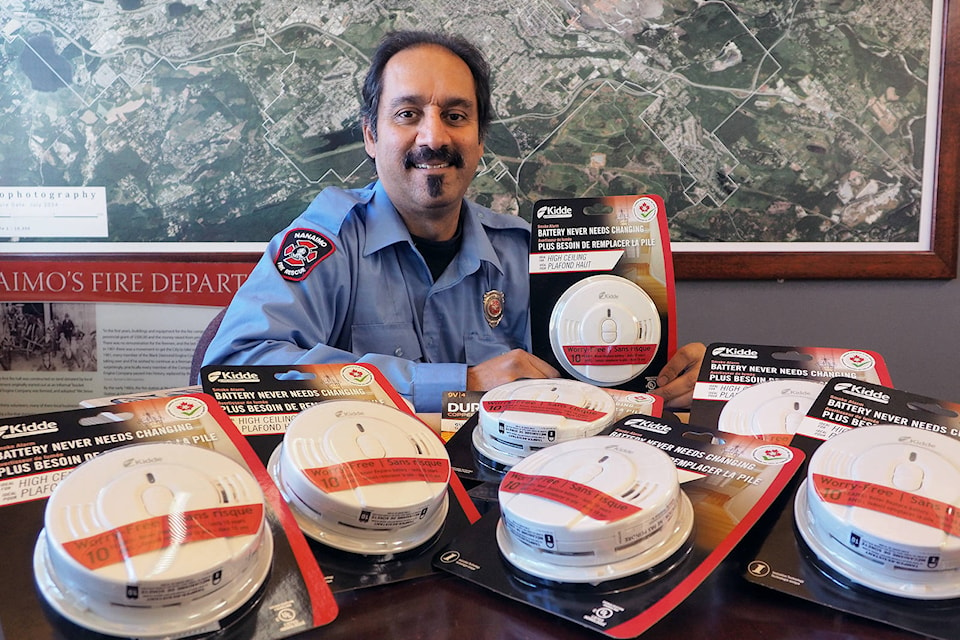Don’t be alarmed if firefighters come knocking on your front door.
Oct. 7-13 is Fire Prevention Week when Nanaimo Fire Rescue’s firefighters will be on a mission to help homeowners prevent fires, ensure they have working smoke alarms and leave residences safer than they were when they arrived.
“This is our second annual door-to-door campaign,” said Umesh Lal, Nanaimo Fire Rescue fire prevention officer.
During Fire Prevention Week 2017 firefighters visited nearly 1,000 private homes in Nanaimo’s downtown, south end and Harewood neighbourhoods where they personally delivered fire safety educational pamphlets and installed smoke alarms in homes that didn’t have them.
The hands-on approach was driven by statistics.
“Last year we started a new campaign. We found that, provincially, the average of working smoke alarms in residential structure fires is way higher than [Nanaimo],” Lal said. “We’re around 25 per cent. The province is around 36 per cent and we found last year that the downtown core was around 18 per cent.”
Lal said the statistics were for the years 2012-2015 and the fire department does not know why Nanaimo’s statistics are so much poorer than the provincial average.
To help get this city’s statistics up to par, firefighters will visit 1,000 more homes in the hospital and Brechin neighbourhoods.
Fire Prevention Week falls on the one-year anniversary of a smouldering fire that broke out in a home on Nicol Street and claimed three lives. Fire investigators found the home had no working smoke alarms that could have alerted the family early enough to rouse them and save their lives.
“We want to educate the citizens and help their survivability in case of a structure fire because with a working smoke alarm it increases 76 per cent … we’ve identified approximately 1,000 addresses so we want to hit those next week,” Lal said.
When firefighters come by they’ll bring not just fire safety educational material, but will also have Kidde brand smoke alarms and Duracell batteries. With the homeowners’ permission, they’ll install new batteries in existing smoke alarms or install new a smoke alarm in homes that don’t have one. The cost of the units and installation is covered under Nanaimo Fire Rescue’s annual operating budget.
“We install them now…” Lal said. “Because we leave the residence safer than it was.”
The model of smoke alarm the fire department is offering requires no maintenance and contains a sealed lithium battery designed to last 10 years, after which time the entire alarm unit is recycled and must be replaced with a new one.
“If they want us in, we go in and we do it,” Lal said. “If they don’t want us in, we leave them the safety information and they can call us back after they think about it and we’ll go do it again.”
If no one is home firefighters will leave fire safety literature that explains where most fires in the home start, what to do in case of a fire, how to form fire escape plan and how often residents should change the batteries in their smoke alarms and test the units. The literature also contains information about the dangers of carbon monoxide poisoning and carbon monoxide detectors.
Firefighters will only visit single-family homes, Lal said, because fire alarm systems in apartment buildings and other multi-family dwellings are the responsibility of the building owner.
Lal said most of Nanaimo’s structure fires happen in the downtown area and most of those are due to cooking or other kitchen mishaps. He said people should test home smoke alarms monthly and change batteries twice a year when clocks are changed to and from daylight savings time.
“The biggest key is to test it monthly … the only way you know it’s going to work is the frequency of testing,” Lal said.
photos@nanaimobulletin.com
Like us on Facebook and follow us on Twitter
